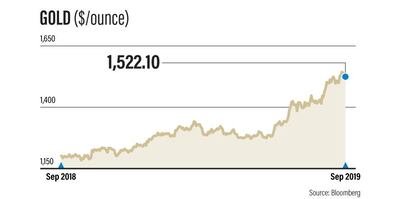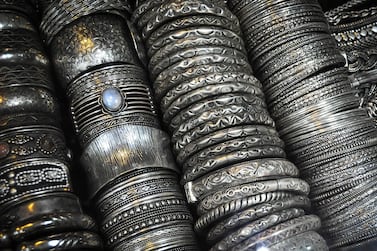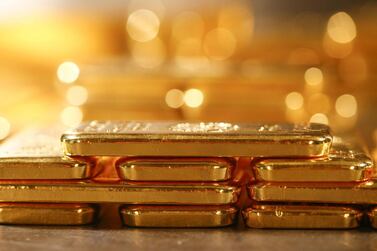Investors are rushing to buy gold with the price hitting a six-year high as global economic and political anxiety rises, and analysts say it could continue to dazzle in the troubled months ahead.
The US-China trade war, pro-democracy protests in Hong Kong, Brexit no-deal fears and a run on the Argentinian peso have fuelled the latest jump to about $1,520 an ounce. That is a rise of 18 per cent from $1,287 three months ago. Inflows into bullion-backed exchange-traded funds topped 100 tonnes in August to hit the highest since February 2013, according to Bloomberg data.
As the world's oldest store of value, gold traditionally swings into favour when investors lose faith in stock markets and paper currencies.
Demand also grows when interest rates start falling as this reduces the return on rival safe havens such as cash and government bonds. But should you be wary of buying at today's higher price?
Josh Saul, chief of London-based gold investment firm The Pure Gold Company, is hiring more staff to deal with an astonishing 632 per cent increase in physical gold bar and coin sales in the final days of August, usually a quiet month of the year. “The speed at which panic-stricken investors are buying gold is similar to the financial crisis in 2007/08, after the collapse of British bank Northern Rock and Lehman Brothers in the US.”
Mr Saul says financial professionals such as bankers, hedge fund managers and financial advisers are joining the gold rush. “They believe a crash is inevitable and will significantly affect global equities and property, while a US recession may be looming.”
Savers also fear banks will start charging savers to hold their money, as interest rates turn negative. "This has already happened in Denmark and Switzerland," says Mr Saul.
He adds that these are not traders looking to make a short profit: "They want the safety and security of a physical asset class that sits outside the banking system, and has a proven track record of increasing in value while others are falling.”
Steen Jakobsen, chief economist and chief investment officer of Saxo Bank, is also bullish, citing the lack of attractive rival investments. “It is now one of the few asset classes that I’m overweight in,” he says.
The fact that gold does not pay any interest is normally seen as a drawback, but that is one of its attractions now that a quarter of the global bond market, $15 trillion in total, is paying negative rates. “These days, something offering zero yield almost looks like a good deal,” Mr Jakobsen says.
The US Federal Reserve cut interest rates by 0.25 per cent in July, and like most analysts he anticipates further cuts this year.
A stock market crash is also likely, possibly by as much as 25 per cent, and Mr Jakobsen says gold is “just about the only choice” for those sceptical about stocks and bonds. “It remains cheap as the price is only just starting to move.”
Arun Leslie John, chief market analyst at Century Financial, is another gold bull, citing the recent inversion of the yield curve as a sign of economic trouble ahead.
The yield curve inverts when the interest rate on long-term US government bonds, or Treasuries, falls below the yield on short-dated bonds — normally you would expect a higher interest rate to compensate for the risk of investing over a longer period.
An inverted US yield curve suggests growth is weakening and is a classic signal of a looming recession, signalling every downturn in the past 50 years.
Central banks in 30 different countries have cut interest rates this year, to pin down their currencies and shield their economies and Mr Leslie John says: “This benefits gold as it reduces the opportunity cost of holding the non-yielding metal. Any dip in the gold price can be viewed as a buying opportunity."

Maged Villegas Hassanain, a financial adviser living in Abu Dhabi, typically keeps up to 10 per cent of his portfolio in gold to balance risk, and is now topping up his holdings.
He sees gold returning to its 2012 peak of nearly $2,000 an ounce, and says it could go even higher as stock markets slip and falling interest rates reduce the appeal of cash and bonds. “Gold is the answer and it has always been, due to its reputation as a value-keeper in times of uncertainty.”
However, Mr Hassanain says gold could hit strong price resistance around $1,590. “Speculators and short term traders are likely to collect their profits around this price, before trying to buy again at lower rates," he adds.
He suggests building any position slowly, and taking advantage of any short-term drop to $1,460 or $1,470. “Needless to say, I could be wrong so don’t forget to cut your losses if you cannot bear to see a sharp decline," he warns. " I would personally sell all my gold if the price dropped below $1,365 per ounce.”
Demos Kyprianou, a board member of SimplyFI, a non-profit community of investing enthusiasts in Dubai, says many private investors shun gold altogether, preferring to leave their wealth in stocks and shares.
He quotes billionaire investor and gold sceptic Warren Buffett, who once said, “It doesn't do anything but sit there and look at you.”
However, Mr Kyprianou says gold does have a place for investors who cannot stomach too much market volatility. “The downside is that your portfolio might trail when times are good and gold is no longer in such demand.”
Central banks have been stockpiling gold, buying a record 374.1 tonnes in the first six months of this year, according to the World Gold Council. That is largest net first-half increase in global gold reserves in the 19 years it has collected quarterly data.
While this should support the price, head of market intelligence, Alistair Hewitt, says some investors have started banking profits. “Consumer demand and price growth may soften as people adapt to the higher price level.”
Gold has had a storming 21st-century, rising 496 per cent in the last 20 years, according to Goldprice.org.
It does not always glisten, though. The gold price can be volatile and could quickly lose its shine when confidence returns. Although given today's anxieties, that day could be a long way off.
Keep an eye on silver and platinum too

Gold isn’t the only precious metal to shine right now. Silver and platinum have been rising at a faster pace over the last month as they play catch up.
While gold has no practical use, which means its price moves largely on sentiment, silver is a different matter. As well as a store of value, it has a host of industrial uses in batteries, dentistry, glass coatings, LED chips, medicine, nuclear reactors, photography, solar energy, semiconductors, touch screens and water purification.
Silver is both up more than 10 per cent in the last month to more than $18 (Dh66.11) an ounce, and 25 per cent over the last year. Platinum, used in catalytic converters and dental work but also a store of value, has grown at a similar pace.
Ole Hansen, head of commodity strategy at Saxo Bank, says investors are jumping into silver and platinum looking for a better value as gold starts to look expensive. “Gold’s impressive rally, which began with the collapse in global bond yields in early June, has left other metals with weaker fundamentals trailing.”
What Mr Hansen calls the “expansion of safe-haven demand” has just seen platinum post its biggest weekly gain since 2015, and all three precious metals could have further to go. “We maintain a bullish outlook with the outlook for global growth, the direction of short and long-term interest rates and a prolonged trade war between the US and China providing the necessary support.”
He says their biggest potential challenge is another of the world’s safe havens, the US dollar. “Renewed dollar strength may provide a challenge in the short-term but as long as gold remains above $1,490 an ounce, we are unlikely to see any major appetite for adjusting long positions.”








